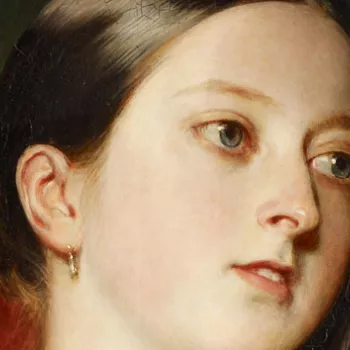The Madonna and Child Signed and dated 1845
Oil on canvas | 80.2 x 58.7 x 2.3 cm (support, canvas/panel/stretcher external) | RCIN 403745
-
The influence of Raphael is clearly evident in this painting, which bears a similarity to works such as The Small Cowper Madonna (Washington, DC, National Gallery of Art). The resemblance was noted by Queen Victoria who described the painting on first seeing it in Buckingham Palace as ‘quite like an old master, & in the style of Raphael – so chaste & exquisitely painted’ (Journal, 9 August, 1845).
While the pose here is tender, the focus is more on religious devotion than maternal affection, the spiritual rather than the sensual. The Virgin reads a Bible passage referring to the stock of Jesse (Isaiah 11) and the child points to Mary as the origin of Christ. The picture was hung in the Queen’s Bedroom at Osborne House. The Queen herself made a pastel copy of it (RCIN 980142), and in 1846 the Prince commissioned from Dyce a companion picture, St Joseph (RCIN 403746), which he considered even finer.
The Scottish artist William Dyce was frequently considered, by both his contemporaries and later generations, to epitomise the Nazarene style of painting in England. While he did make several trips to Rome and probably met members of the Nazarene group working there during the 1820s Dyce’s style is more illusionistic and sculptural than the flat style championed by the Nazarenes and he himself consistently denied any link with the group. The Nazarenes were fascinated by the technique of fresco, an interest also cultivated by Dyce. His colossal Neptune resigning the Empire of the Seas to Britannia, painted on the upper wall of the stairwell at Osborne House, was commissioned by Prince Albert in 1846 and completed in 1847.
Dyce was involved in religious revivalism in England, and, like Prince Albert, emphasised the importance of the public role of art in society, for example designing the certificates for exhibitors at the Great Exhibition of 1851. Working at the Government School of Design at Somerset House, he was involved in the design of the lace for Queen Victoria’s wedding dress (Staniland and Levey, 1983, pp. 28-30). Prince Albert and the artist also shared an interest in early music – the Prince having been appointed a director of the Concerts of Antient Music in 1840 and Dyce having founded the Motett Society in 1844.
Text adapted from 'Victoria and Albert: Art & Love', London, 2010Provenance
Purchased by Prince Albert, 1845
-
Creator(s)
Acquirer(s)
-
Medium and techniques
Oil on canvas
Measurements
80.2 x 58.7 x 2.3 cm (support, canvas/panel/stretcher external)
119.0 x 94.0 x 12.5 cm (frame, external)










